Items
Site
The Medicine Chest
keywords is exactly
experiment
-

Weighing Smoke
PAUL That’s the man. Well, Raleigh was the person who introduced tobacco in England, and since he was a favourite of the Queen’s – Queen Bess, he used to call her – smoking caught on as a fashion at court. I’m sure Old Bess must have shared a stogie or two with Sir Walter. Once, he made a bet with her that he could measure the weight of smoke. DENNIS You mean, weigh smoke? PAUL Exactly. Weigh smoke. TOMMY You can’t do that. It’s like weighing air. PAUL I admit it’s strange. Almost like weighing someone’s soul. But Sir Walter was a clever guy. First, he took an unsmoked cigar and put it on a balance and weighed it. Then he lit up and smoked the cigar, carefully tapping the ashes into the balance pan. When he was finished, he put the butt into the pan along with the ashes and weighed what was there. Then he subtracted that number from the original weight of the unsmoked cigar. The difference was the weight of the smoke. TOMMY Not bad. That’s the kind of guy we need to take over the Mets. PAUL Oh, he was smart, all right. But not so smart that he didn’t wind up having his head chopped off twenty years later. (Pause) But that’s another story. -
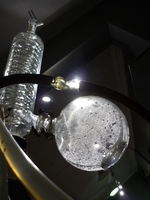
The experiment (Wine into water)
An experiment in three parts, reversing the first miracle. -
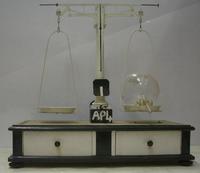
Weighing Air
An example from demonline (UCT Physics Department’s website with descriptions of educational demonstrations). Its descriptions reads: "A spherical flask of about 1 litre is suspended from one arm of a crude chemical balance. It is counterpoised by weights in the other pan, the tap attached to the sphere being open. This gives (roughly) the true weight of the glass. Unhook the sphere from the stirrup, attach the rubber tube from a rotary vacuum pump to the glass tube and evacuate for around 30s. Close tap, and re-attach stirrup. There will now be an upthrust on the flask equal to the weight of air removed, and the weights in the other pan will have to be reduced by about 1.2 g to restore the balance. Open the tap again: the air can be heard rushing into the flask (class must keep quiet), and the flask suddenly descends again". -

Lodestone
An example from demonline (UCT Physics Department’s website with descriptions of educational demonstrations). Its description reads: ‘A lodestone is suspended by a string. Show that it rotates on bringing a magnet near it. Dip it into iron filings and show that it picks them up.’ -
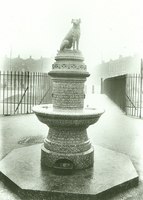
The Brown Dog Affair (1903 - 1910)
On Feb. 2, 1903, English physicians William Bayliss and Ernest Starling, gave a lecture on the digestive system to a theatre full of medical students. Also in attendance were Lizzy Lind af Hageby and Leisa Schartau, committed feminists and anti-vivisectionists. They had travelled from Sweden to enrol at the London School of Medicine for Women, attend lectures around town, and document the practice of vivisection in British universities. During the lecture, a brown terrier was wheeled out, strapped to a board. Starling had already performed one experiment on the dog two months earlier, shutting off its pancreas. This time, Bayliss cut open the dog’s neck and spent half an hour unsuccessfully trying to stimulate the animal’s salivary glands with electrodes. Eventually, he gave up and handed the dog over to a student (Henry Dale, another future Nobel laureate) who stabbed it through the heart, thus ending the lesson. What followed was a court case filed by Stephen Coleridge, a prominent barrister and secretary of the National Anti-Vivisection Society against Bayliss. After four days of testimony, the judge called the women’s account “hysterical” while giving instructions to the jury. The jurors conferred for 20 minutes, then found Coleridge guilty of libel. Anti-vivisectionists commissioned a bronze statue of the dog as a memorial, unveiled in Battersea in 1906. Its plague, which read "Men and women of England, how long shall these Things be?" led to the it being vandalised on a frequent basis. On 10 December 1907, hundreds of medical students marched through central London waving effigies of the brown dog on sticks, clashing with suffragettes, trade unionists and 300 police officers, one of a series of battles known as the ‘Brown Dog’ riots. In March 1910, tired of the controversy, Battersea Council sent four workers accompanied by 120 police officers to remove the statue under cover of darkness, after which it was reportedly melted down by the council's blacksmith. -
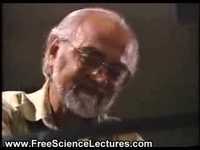
Rats laugh when you tickle them
In 1999, Jaak Panksepp and Jeffrey Burgdorf successfully demonstrated that tickling young rats spurs them into letting out the same ultrasonic giggles they make during play. -

Kuhn's Jellyfish
Kuhn's "example illustrates how the entrenched expectations of experimental outcomes and prescribed instrumental functions of an insider’s view of the laboratory and its equipment can pose a threat to new discoveries. The circumstances that enabled Roentgen (an insider) to first notice these new rays are not clear, but Kuhn proposes that the occurrence of anomaly enables discovery and that Roentgen’s ‘recognition that nature has somehow violated the paradigm-induced expectations that govern normal science’ (1970: 52–3) was important. Kuhn emphasises that Roentgen valued the anomaly instead of ignoring it – a vital step in the process of discovery" (Liebenberg 2021: 114). -
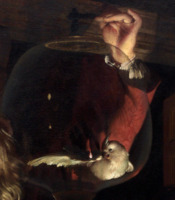
Canary
Sentinel species are used to detect risks to humans by providing advance warning of a danger. The idea of placing warm-blooded animals in a mine to detect carbon monoxide was first proposed by the Scottish physiologist John Scott Haldane in 1913. Canaries (Serinus canaria ) were considered the best sentinel animals for detection of dangerous gases because they were found to be more sensitive than other species evaluated (Pollock 2016:386-387). -
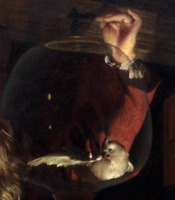
Flight
A chorus of juvenile heartbeats affected by Atrial Septal (ASD) and Ventricular Septal Defects (VSD), Patent Ductus Arteriosus(PDA), and Aortic Valve Stenosis (AVS), transposed to a higher frequency to simulate birdsong -
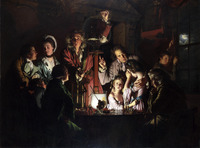
An Experiment on a Bird in the Air Pump
In Joseph Wright’s 'An Experiment on a Bird in the Air Pump' (1768), he depicts the re-enactment of Boyle’s famous experiment. Contrary to the restricted viewing of this experiment in the confines of Gresham College by the gentleman of the Royal Society, this audience includes a variety of individuals of different ages and gender, exhibiting a mixture of emotions: a young girl worriedly watches the fate of the bird, while another is comforted by her father, seemingly too upset to view the rest of the experiment; a young boy and middle-aged man look on with absorption, while two young lovers only have eyes for each other; lastly an old man meditates on a skull in a jar, and the scientist stare out at the viewer, and not at the experiment. -

Modest_ Witness@Second _Millenium
Boyle's 'New Experiments Physico-Mechanical Touching the Spring of the Air', which describes experiments with an air-pump, recounts a demonstration attended by high-born women at which small birds were suffocated by the evacuation of the chamber in which the animals were held. Since the ladies interrupted the experiments by demanding that air be let in to rescue a struggling bird, Boyle reported that “to avoid such difficulties, the men later assembled at night to conduct the procedure and attest to the results” (Haraway 2004: 232). -

Heart of Cape Town Museum
Christiaan Barnard did forty-eight trial transplants with dogs before he undertook such an operation with a human being.


